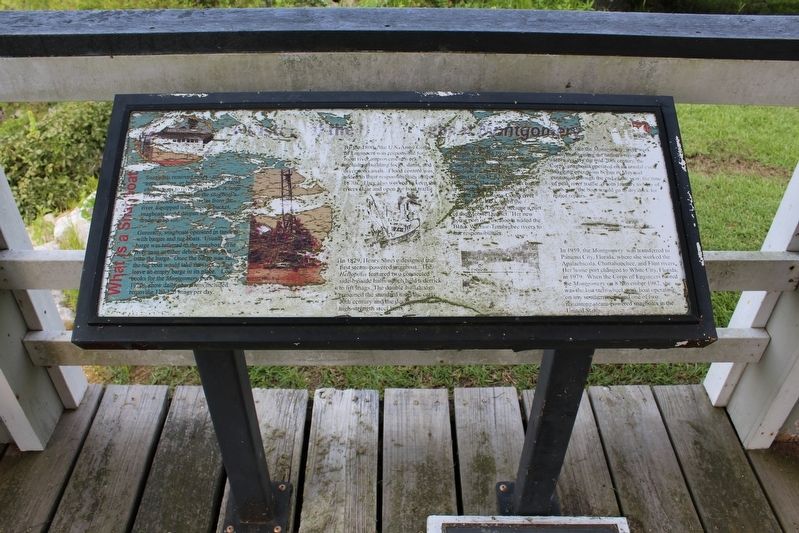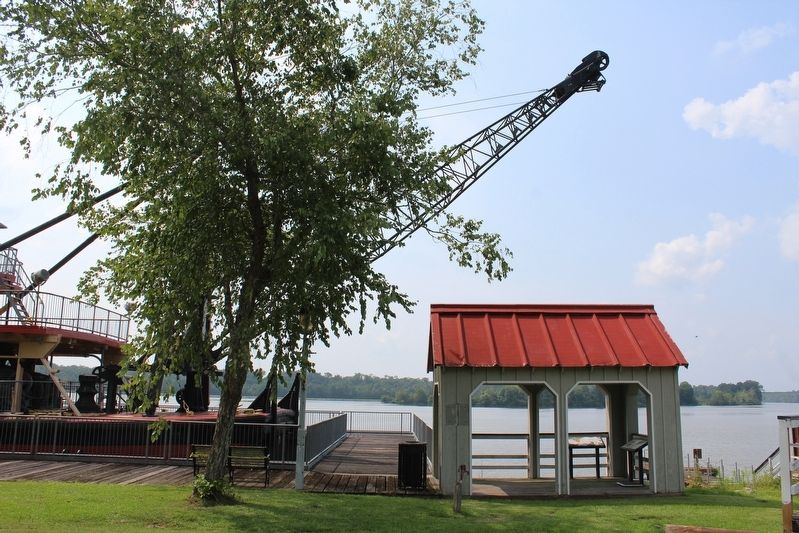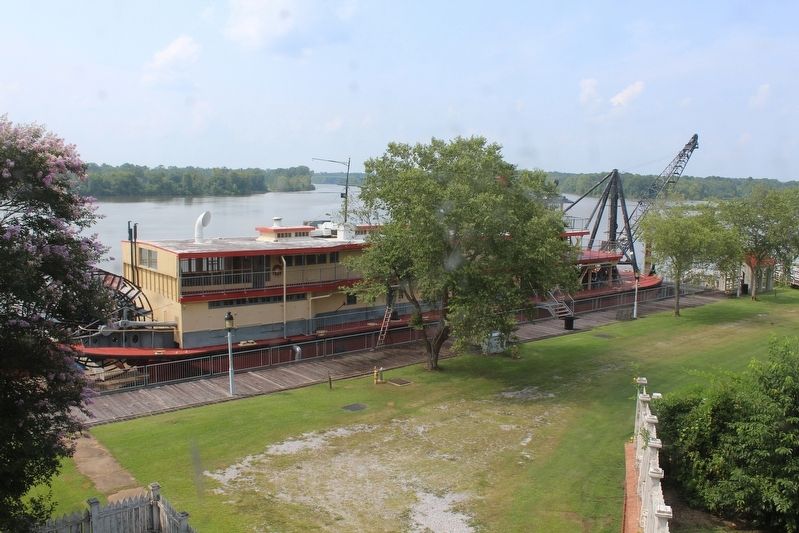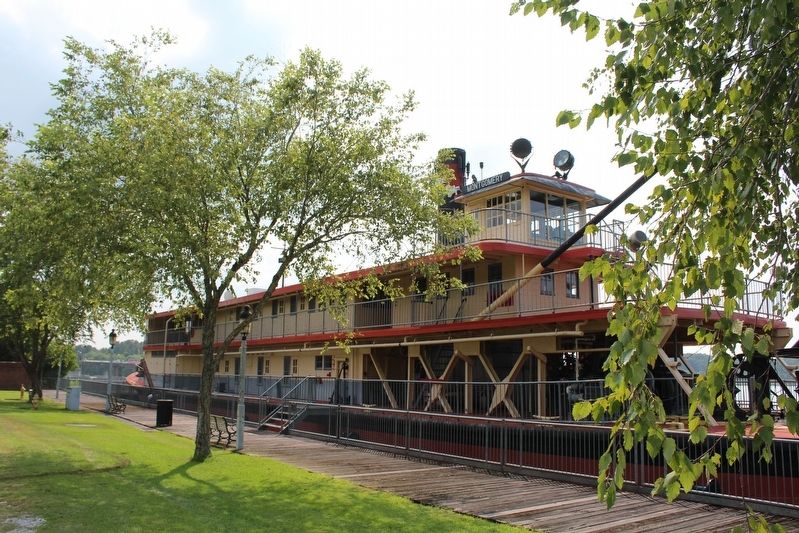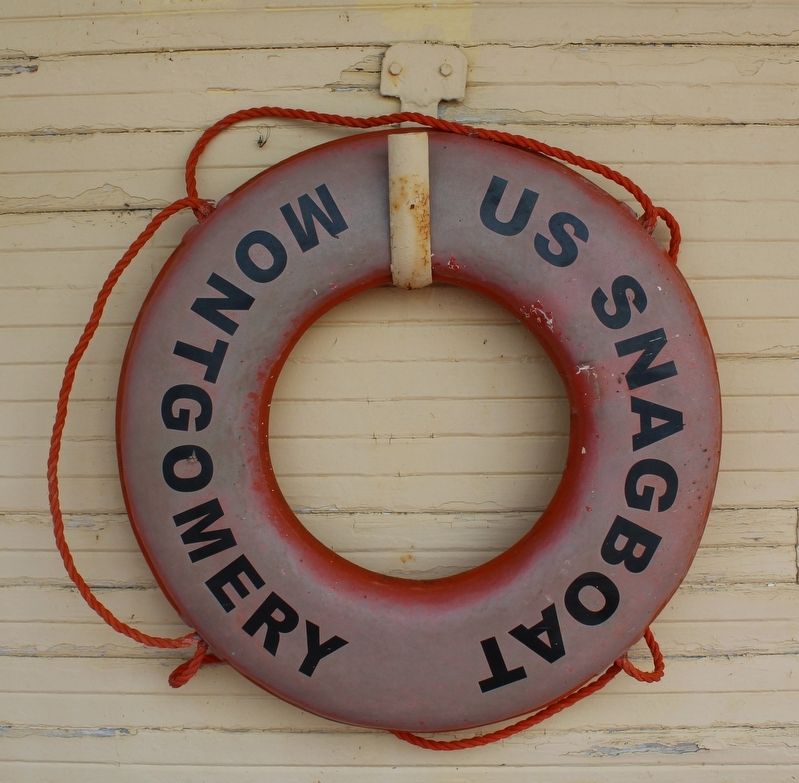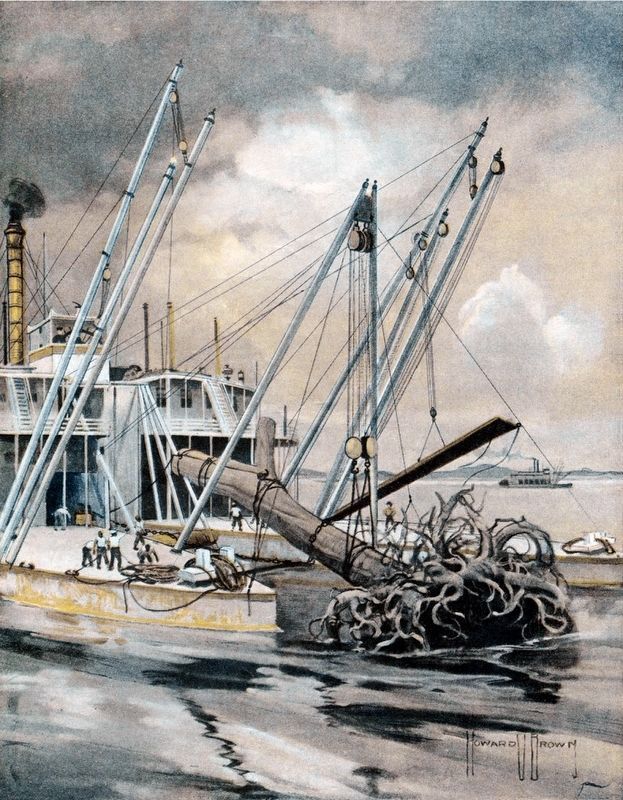Near Pickensville in Pickens County, Alabama — The American South (East South Central)
History of the Snagboat Montgomery
What is a Snagboat?
Snagboats remove snags – underwater trees, stumps, or branches – that created obstructions to river navigation. A large grapple or clamshell on the snagboat’s beam pulled these obstacles from the river. Equipped with a scoop bucket, snagboats could deepen shallow areas by dredging up silt.
Generally, snagboats operated in tandem with barges and tug boats. Usually, a barge was tethered to the snagboat. The river snag or other debris was dropped onto the barge. Once the barge was full, the tug boat would take it away and leave an empty barge in its place. Log books for the Montgomery from the 1970s, show daily operations included removing 120-170 snags per day.
By the 1800s, The U.S. Army Corps of Engineers was responsible for most river improvement work including building locks, dams, and diversion canals. Flood control was added to their responsibilities in the 1870s. They also worked to keep the rivers clear and open for boat traffic.
In 1829, Henry Shreve designed the first steam-powered snagboat. The Heliopolis featured two connected side-by-side hulls which held a derrick to lift snags. The double-hull design remained the standard until the early 20th century and the development of high-strength steel hulls.
The Montgomery was built between 1925 and 1926 by the Charleston Dry Dock and Machine Company of Charleston, South Carolina, for the Montgomery District of the U.S. Army Corps of Engineers. The new boat was based in Montgomery, Alabama, and worked the Alabama-Coosa River system until 1933, when the Montgomery District became a part of the Mobile District. Her new home port of Tuscaloosa added the Black Warrior-Tombigbee rivers to her responsibilities.
Snagboats, like the Montgomery, were work horses, maintaining the nation’s navigable waterways. By the mid-20th century, the Corps’ snagboats operated on an annual cycle. Snagging operations began in May and continued through the end of the year, the time of peak river traffic. From January to May of each year, the boat would go to dry dock for major repairs.
In 1959, the Montgomery was transferred to Panama City, Florida, where she worked the Apalachicola, Chattahoochee, and Flint rivers. Her home port changed to White City, Florida in 1979. When the Corps of Engineers retired the Montgomery on 8 November 1982, she was the last sternwheel work boat operating on a southern river and one of two remaining steam-powered snagboats in the United States.
Erected by U.S. Army Corps of Engineers - Mobile District.
Topics. This historical marker is listed in this topic list: Waterways & Vessels. A significant historical date for this entry is November 8, 1982.
Location. 33° 12.747′ N, 88° 17.143′ W. Marker is near Pickensville, Alabama, in Pickens County. Marker can be reached from Lock and Dam Road, half a mile south of Marina Parkway, on the right when traveling south. Located near the Tom Bevill Visitor Center. Touch for map. Marker is at or near this postal address: 1382 Lock & Dam Rd, Carrollton AL 35447, United States of America. Touch for directions.
Other nearby markers. At least 8 other markers are within 10 miles of this marker, measured as the crow flies. The Tennessee - Tombigbee Waterway (here, next to this marker); The U.S. Snagboat Montgomery (about 400 feet away, measured in a direct line); Pickensville Historic District (approx. 1½ miles away); Historic Pickensville Rosenwald School (approx. 2½ miles away); Aliceville First Baptist Church (approx. 7.3 miles away); George Downer Field (approx. 9.1 miles away); R. J. Kirksey High School (approx. 9.2 miles away); Aliceville Prisoner of War Camp (approx. 9.3 miles away). Touch for a list and map of all markers in Pickensville.
More about this marker. Marker is in a weathered condition.
Also see . . . Online Steamboar Museum - Steamboat Snag Boats. Contains many illustrations and photographs. Excerpt:
The maximum speed of the snag boats, each of which is about 190 feet long and 95 feet wide and carries a crew of 45 men, is approximately 8¾ miles an hour in still water. Ordinarily, the snags point down-stream and often are buried anywhere from 10 to 40 feet deep in the mud, the tendency for trees which are carried away in the shore —undermining activities of the turbulent waters being to right themselves and to settle in the sand in an erect, upstanding position. The snags are so securely anchored that they rip holes in the bottoms of vessels which collide with them. Waterlogged, anchored snags effect the greatest damage ; river pilots have had to contend with them ever since navigation between New Orleans and St. Louis was begun.(Submitted on November 11, 2023.)
The position of the snag in the water is indicated by the V-shaped break which it causes in the surface of the river. A snag submerged even as deep as 30 or 40 feet causes a boil in the overhead surface water which is easily recognizable by the lookouts on the snag boats. The Federal snag boats are of the double-bowed, catamaran type with a steel butting beam 15 feet long and 10 feet wide connecting the bows. When a snag is sighted, the boat is maneuvered close to the point where the V-shaped break appears on the water surface so that the crew can lower a huge sweep chain operated by means of 4 engine-driven capstans, each of which can exert a pull of 35 tons. The chain finally will engage the snag and raise its free end out of the water. Windlass chains are then used to haul the snag on to the beam, a special engine being used to run an enormous drum which releases or winds up a huge sansom chain that can resist a strain of 75 tons. The individual links in this chain weigh 27½ pounds and are made out of round iron 2¾ inches in diameter.
Additional keywords. History of the Snagboat Montgomery
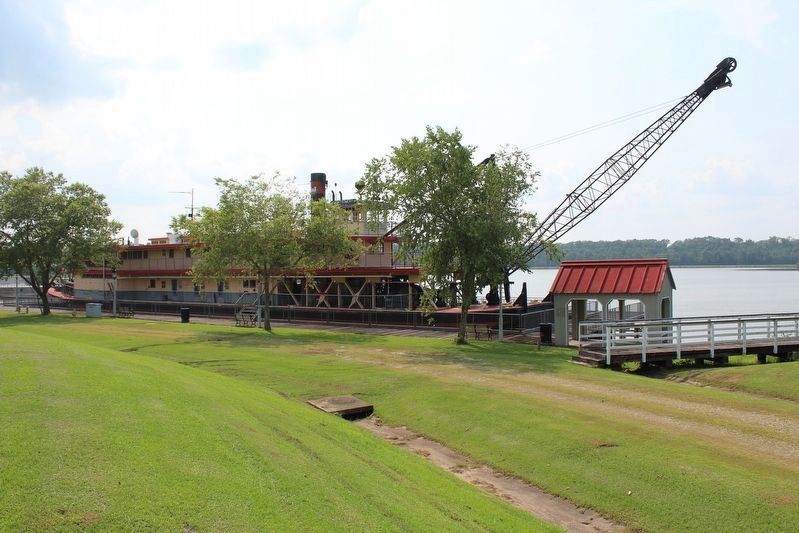
Photographed By Tom Bosse, July 30, 2021
6. U.S. Snagboat Montgomery - A National Historic Landmark
US Army Corps of Engineers, Mobile District website entry
Click for more information.
Click for more information.
Credits. This page was last revised on November 19, 2023. It was originally submitted on August 8, 2021, by Tom Bosse of Jefferson City, Tennessee. This page has been viewed 400 times since then and 65 times this year. Last updated on November 13, 2023, by Carl Gordon Moore Jr. of North East, Maryland. Photos: 1, 2, 3, 4, 5, 6. submitted on August 8, 2021, by Tom Bosse of Jefferson City, Tennessee. 7. submitted on November 11, 2023, by J. J. Prats of Powell, Ohio. • James Hulse was the editor who published this page.
